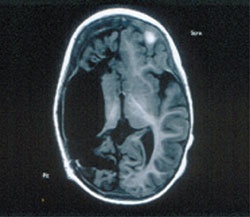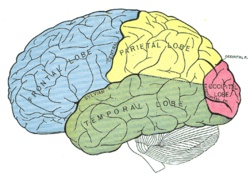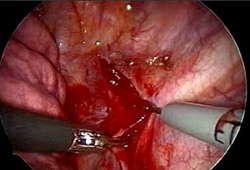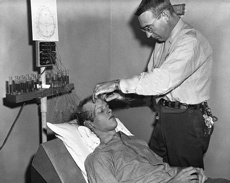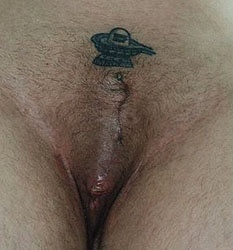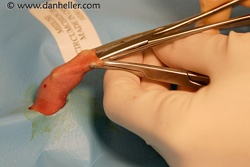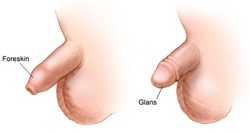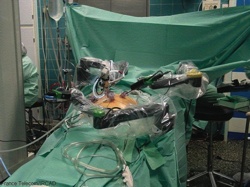- Hemispherectomy
Believe it or not, this surgical procedure involves removing or disabling an entire half of the brain. This procedure is used to treat a variety of seizure disorders where the source of the epilepsy is localized to a broad area of a single hemisphere of the brain. It is reserved for cases which can’t be managed with medication alone. The first time this surgery was performed on a human was in 1923 by Walter Dandy. All of the patients who receive this treatment suffer from partial or full paralysis on the side of the body opposite to the side of the brain removed. Most patients who have undergone this procedure will have neurons from the remaining hemisphere take over the tasks from the lost hemisphere by making new neural connections.
- Hemicorporectomy
Also known as translumbar amputation, this surgery removes the lower half of the body from above the pelvis. The result is that the sexual organs, anus, rectum, legs, pelvis bones, and urinary system are removed. It is a severely mutilating procedure recommended only as a last resort for patients with severe and potentially fatal illnesses such as osteomyelitis, tumors, severe traumas and intractable decubiti in, or around, the pelvis. This surgery has only been performed in a small number of cases. The surgical procedure is often done in two stages; however it is possible to conduct the surgery in one stage. The first stage is the discontinuation of the waste functions in colostomy (rectum) and ileal conduit (bladder). The second stage will be the actual amputation. 3. Bilateral Cingulotomy
This is a brain surgery used in pain treatment for severe cases of cancer. It involves disabling the cingulate gyrus, a small section of brain that connects the limbic region of the brain with the frontal lobes. It has also found use in psychosurgery (surgery for mental disorders) where it is very controversial. As a psychosurgical treatment it has almost totally replaced lobotomy as a procedure. Its use for alleviation of pain in cancer patients is reasonably well-documented and well-supported, but its use in treating people with depression is not.
- Endoscopic Thoracic Sympathectomy
ETS is a surgery in which oprtions of the sympathetic nerve trunk are dissected. By cutting these nerve sections, the surgeon is able to treat severe cases of hyperhydrosis (excess sweating). What makes this bizarre is that a side-effect of this treatment is that the person no longer blushes. For that reason it has also become a cosmetic procedure for people who blush excessively. If only one side of the body is treated, a person who has undergone this surgery will have half of their body blushing while the other half remains in its natural state. For this reason the treatment is always performed on both sides of the body. 5. Vaginectomy
In a Vaginectomy, part or all of the vagina is surgically removed. This is normally used as a treatment for various forms of cancer but it also occurs in some sexual reassignment surgeries. It is normal for a surgeon to reconstruct the vagina after this surgery by using other parts of the patient’s body.
- Lobotomy
Lobotomy is a very controversial medical treatment in which the frontal lobes of the brain are destroyed. It consists of cutting the connections to and from, or simply destroying, the prefrontal cortex. While it is seldom performed nowadays, it does still occur. Lobotomies have been used in the past to treat a wide range of mental illnesses including schizophrenia. This procedure often results in major personality changes or even mental retardation. President Kennedy’s sister was given a lobotomy. Wikipedia has this to say: 7. Penectomy
A Penectomy is the total removal of all, or parts, of the penis. It is normally used as a treatment for cancer, but it has sometimes had to be performed after a botched circumcision. Some men have undergone penectomies as a voluntary body modification, but professional opinion is divided as to whether or not the desire for penile amputation is a pathology, thus including it as part of a body dysmorphic disorder. 8. Circumcision
Circumcision is a very common procedure performed for religious reasons (amongst Jews and Muslims) and by many doctors who claim health benefits. Much controversy surrounds this procedure (in which the foreskin of the penis is surgically removed) as it is a non-essential surgery normally performed on a child that has no say in whether it is performed or not. Some adult men develop psychological issues as a result of circumcision, which leads us to the next bizarre surgery: foreskin restoration. 9. Foreskin Restoration
Foreskin restoration is the process of expanding the residual skin on the penis, via surgical or non-surgical methods, to create the appearance of a natural foreskin (prepuce) covering the glans penis. Foreskin restoration techniques are most commonly undertaken by men who have been circumcised or who have sustained an injury, but are also used by uncircumcised men who desire a longer foreskin and by men who have phimosis. Some men cite a desire to regain a sense of control over their sexual organs and regaining lost self esteem. European Jews, along with men circumcised for medical reasons, sought out underground foreskin restoration operations during World War II as a method to escape Nazi persecution. 10. Lindbergh Operation
The Lindbergh Operation is included here as a special mention. It was the first surgery ever performed entirely with robots being guided by doctors through telecommunications. The surgery occurred in France and was controlled by French doctors in New York. The operation was performed successfully on September 7th, 2001 by Professor Jacques Marescaux and his team from the IRCAD (Institute for Research into Cancer of the Digestive System). This was the first time in medical history that a technical solution proved capable of reducing the time delay inherent to long distance transmissions sufficiently to make this type of procedure possible. The 45-minute procedure consisted in removing the gallbladder of a patient in surgical ward A in Strasbourg Civil Hospital, in Eastern France. From New York, the surgeon controlled the arms of the ZEUS™ Robotic Surgical System, designed by Computer Motion, to operate on the patient. The link between the robotic system and the surgeon was provided by a high-speed fiberoptic service deployed thanks to the combined efforts of several France Telecom group entities. Sources: Wikipedia
Technorati Tags: Bizarre, surgery
Read More: Twitter Facebook YouTube Instagram
